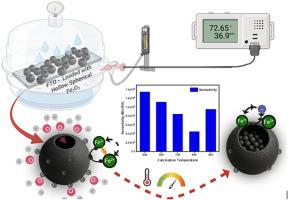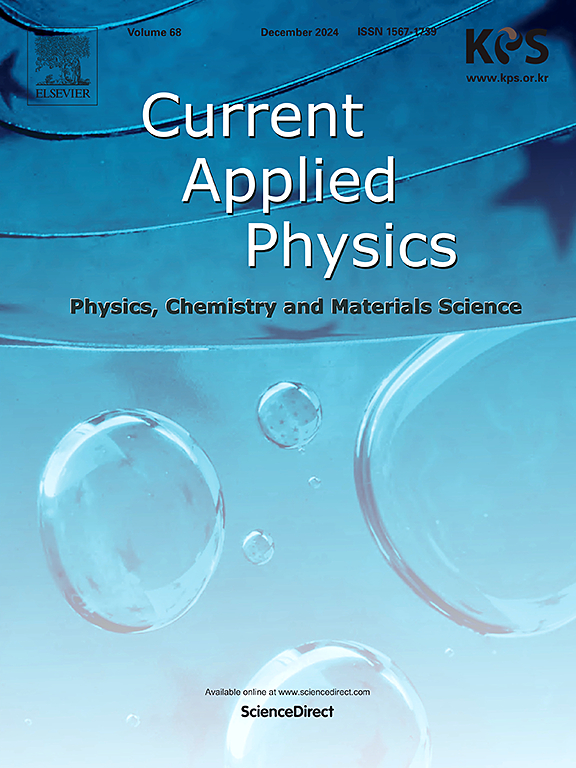Autonomous sampling of α-Fe2O3 hollow microspheres with carbon-stabilized defects: calcination-tuned humidity sensor performance
IF 3.1
4区 物理与天体物理
Q3 MATERIALS SCIENCE, MULTIDISCIPLINARY
引用次数: 0
Abstract
Defect control and surface chemistry remain critical bottlenecks in advancing metal-oxide humidity sensors. We report a scalable mechano-thermal strategy for fabricating carbon-doped α-Fe2O3 hollow microspheres, whose intrinsic voids act as autonomous sampling chambers. Systematic calcination (500–900 °C) enables precise tuning of crystallite size (38.2–87.6 nm), lattice strain (0.10–0.77 %), dislocation density (1.4 × 10−4–3.07 × 10−3 nm−2), and carbon content (21 → 14 wt%), thereby modulating carbon–oxygen moieties that govern water adsorption and proton-hopping conduction. Spectroscopic analyses reveal a stable Fe2+/Fe3+ surface ratio and C–Fe–O interactions, generating hydrophilic adsorption sites and activating a dual-regime mechanism: ionic conduction dominates up to 75 % RH, while Grotthuss proton transport prevails at higher humidity. Non-monotonic phase evolution with transient Fe3O4 nucleation at 800 °C highlights the role of dynamic defect activation. The Fe-500 device delivers superior performance, with a sensitivity of 0.75 kΩ/% RH, response time of 40 s, and recovery time of 85 s, surpassing benchmark hematite-based sensors.

具有碳稳定缺陷的α-Fe2O3空心微球的自主采样:煅烧调谐湿度传感器性能
缺陷控制和表面化学仍然是推进金属氧化物湿度传感器的关键瓶颈。我们报道了一种可扩展的机械热策略,用于制造掺杂碳的α-Fe2O3空心微球,其固有空隙充当自主采样室。系统煅烧(500-900°C)可以精确调节晶体尺寸(38.2-87.6 nm),晶格应变(0.10 - 0.77%),位错密度(1.4 × 10−4-3.07 × 10−3 nm−2)和碳含量(21→14 wt%),从而调节控制水吸附和质子跳跃传导的碳氧组分。光谱分析揭示了稳定的Fe2+/Fe3+表面比和C-Fe-O相互作用,产生亲水性吸附位点并激活双重机制:在75% RH下离子传导占主导地位,而在更高湿度下Grotthuss质子传输占主导地位。800℃下瞬态Fe3O4成核的非单调相演化突出了动态缺陷激活的作用。Fe-500器件具有优异的性能,灵敏度为0.75 kΩ/% RH,响应时间为40 s,恢复时间为85 s,优于基准赤铁矿传感器。
本文章由计算机程序翻译,如有差异,请以英文原文为准。
求助全文
约1分钟内获得全文
求助全文
来源期刊

Current Applied Physics
物理-材料科学:综合
CiteScore
4.80
自引率
0.00%
发文量
213
审稿时长
33 days
期刊介绍:
Current Applied Physics (Curr. Appl. Phys.) is a monthly published international journal covering all the fields of applied science investigating the physics of the advanced materials for future applications.
Other areas covered: Experimental and theoretical aspects of advanced materials and devices dealing with synthesis or structural chemistry, physical and electronic properties, photonics, engineering applications, and uniquely pertinent measurement or analytical techniques.
Current Applied Physics, published since 2001, covers physics, chemistry and materials science, including bio-materials, with their engineering aspects. It is a truly interdisciplinary journal opening a forum for scientists of all related fields, a unique point of the journal discriminating it from other worldwide and/or Pacific Rim applied physics journals.
Regular research papers, letters and review articles with contents meeting the scope of the journal will be considered for publication after peer review.
The Journal is owned by the Korean Physical Society.
 求助内容:
求助内容: 应助结果提醒方式:
应助结果提醒方式:


